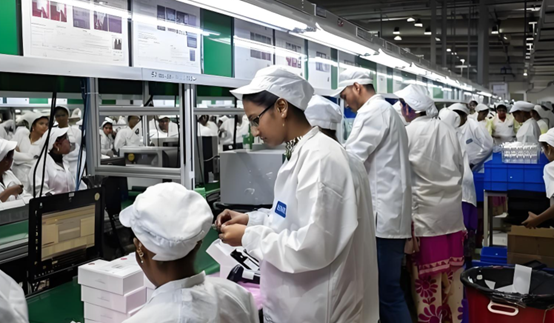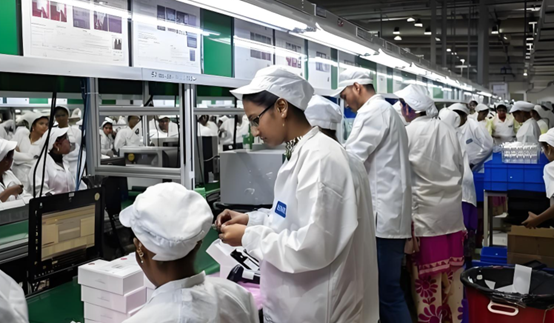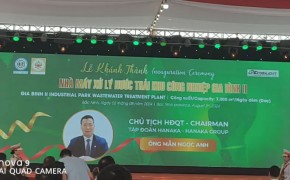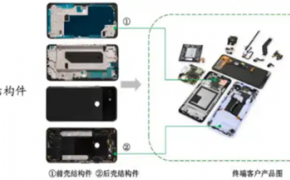近日印度经济时报称,鸿海与印度当地政府已进行多次洽商,就在泰米尔纳德邦的生产设施组装苹果平板电脑iPad产品,进行相关的投资资本补贴,以及园区运营政策等进行协调,如果相关政策符合预期,富士康将迁一条苹果平板电脑iPad产品生产线过去,实现iPad在印度本土生产制造。
在外界纷纷议论苹果在印度生产iPhone产品,由于印度政府限制中国大陆员工签证,导致印度富士康和塔塔集团遭遇了技术员工短缺,产线生产良率不高,以及产品消毒不严格受到部分出口市场抵制后,富士康即将在印度生产iPad的消息,侧面反映了外界对印度扩充苹果供应链的信心。
此前富士康子公司工业富联计划在印度泰米尔纳德邦建设一座新的电子元件工厂,工业富联计划投资160亿印度卢比(约合1.94亿美元或13.92亿元人民币)用于该工厂的建设,预计今年完工后投入生产。工厂将位于泰米尔纳德邦首府金奈附近的Kancheepuram区,与富士康目前在金奈的另一座庞大园区分开。
不过今年以来由于多种原因,小米公司突然削减了另一座庞大园区富士康印度子公司Bharat FIH的订单量,削减幅度高达70%。这一决定对富士康在印度,特别是金奈工厂的生产线造成了严重影响。

为了更好的保证新工厂的投资进行,以及原园区的正常运作,鸿海与当地政府就新增iPad生产线进行了多轮的协商。但鉴于金奈政府以往并不怎么好的运营政策,以及行政执行不严谨的习性,鸿海的谈判应该十分艰难。
因此从对外吹风有几个月了,对于何时在印度量产iPad产品,富士康和苹果都对外还没有确定的消息公布。
为了更好的在印度生产苹果的产品,鸿海以及苹果的海外供应链企业,近期组织了庞大的游说团体,对印度各地政府进行改善投资环境的公关,包括推出新的投资资本补贴计划,新的电力保证机制,新的员工劳动法规等,
另外是积极推动印度各级政府放宽中国大陆在印度的光伏、手机制造业投资限制,以保证苹果产品在印度制造可以获得足够的绿电来积累碳积分,同时在电力紧缺的高峰期,以有限的绿电来保证产线的正常周转仓储与运行等。
而在引进中国大陆制造业人才上,也是苹果供应链企业和印度本土制造企业共同关心的问题。
印度本土制造业企业曾推动政府对中国大陆企业,在投资与人员往来上进行全面的打压与封锁,导致近四年间,不但中国大陆的员工无法进入到印度本土工作,而且原来还在印度工作的员工,也经常遭遇不明的审查与羁押,人身安全受到威胁,中国大陆员工不再愿意前往印度工作。
这种状况不但让在印度的中资企业难以开展业务,就是印度的本土制造业企业,想从中资企业中获得技术外溢或熟手员工红利,也几乎没了可能,很多印度本土企业在截胡了中资企业的行业订单后,即买不到中国大陆便宜好用的高效率生产设备,也找不到会开这些设备的员工,而且即便是购买高价的标准设备来改装替代,同样也在市场上找不足足够的开机人员。
当然中资企业相关在印度的投资也几乎停滞,进入的远少于撤走的资本。这中国大陆几乎占据了约90%以上的光伏上游制造装备和原材料产能,与90%以上手机制造装备设备与低值易耗品产能的情况下,中国大陆对印度政府刻意破坏经贸与投资环境的行为,再也不愿再假以辞色。
加上印度在引进光伏和面板制造产能时,又好高骛远,不愿二手产线或接受成熟制程,也不愿自己建设相关的环保处理基础设施,因此全球资本对在印度投资相关制造产能一直兴趣缺缺。
无耐之下,今年以来,印度政府一直想弄清楚中国大陆在光伏与面板等大宗商品上的产能配额机制,但中方并没有对印度进行回应。
因此相关的游说团体在印度积极活动对印度政府施压的同时,印度的本土制造业企业以及印度政府也开始反思,要如何加入到中国大陆的供应链体系,来完善印度制造业的技术与产能积累。
近期相关的游说团体和印度政府方面也开始对中国大陆喊话,希望能够重新取得商业互信。
而苹果此次决定让富士康在印度生产iPad产品,据了解如果无法稳定获得中国LCD面板供应的话,有可能先从配备AMOLED面板的高级产品开始,先从越南三星和富士康抽调人员到印度培训员工组织生产。
Recently, the India Economic Times said that Hon Hai and the local government of India have held several negotiations to assemble Apple tablet iPad products at production facilities in Tamil Nadu, carry out relevant investment capital subsidies, and coordinate park operation policies, if the relevant policies meet expectations, Foxconn will move an Apple tablet iPad product production line to the past to achieve iPad production in India.
After the outside world has talked about Apple's production of iPhone products in India, due to the India government's restrictions on Chinese mainland employee visas, resulting in India's Foxconn and Tata Group suffering from a shortage of skilled workers, the production line yield rate is not high, and the product disinfection is not strict and is boycotted by some export markets, the news that Foxconn is about to produce iPad in India reflects the confidence of the outside world in India's expansion of Apple's supply chain.
Previously, Foxconn's subsidiary FII planned to build a new electronic component factory in Tamil Nadu, India, and FII plans to invest 16 billion India rupees (about 194 million US dollars or 1.392 billion yuan) in the construction of the plant, which is expected to be completed and put into production this year. The factory will be located in the Kancheepuram district near Chennai, the capital of Tamil Nadu, separate from Foxconn's other sprawling campus currently in Chennai.
However, since the beginning of this year, for a variety of reasons, Xiaomi has suddenly cut orders for Bharat FIH, another huge campus Foxconn subsidiary in India, by as much as 70%. This decision has had a serious impact on Foxconn's production lines in India, particularly at its Chennai plant.

In order to better ensure the investment of the new factory and the normal operation of the original park, Hon Hai and the local government have conducted several rounds of negotiations on the new iPad production line. However, given the Chennai government's poor operational policies and lax administrative execution, Hon Hai's negotiations should be difficult.
Therefore, it has been a few months since the external briefing, and Foxconn and Apple have not yet announced the news on when the iPad products will be mass-produced in India.
In order to better produce Apple's products in India, Hon Hai and Apple's overseas supply chain companies have recently organized a large lobby group to conduct public relations to improve the investment environment for governments across India, including the introduction of a new investment capital subsidy program, a new power guarantee mechanism, and new employee labor regulations
In addition, it is actively promoting India's governments at all levels to relax Chinese mainland's investment restrictions on photovoltaic and mobile phone manufacturing in India, so as to ensure that Apple products manufactured in India can obtain enough green electricity to accumulate carbon credits, and at the same time, during the peak period of power shortage, limited green electricity is used to ensure the normal turnover, storage and operation of production lines.
The introduction of manufacturing talents from Chinese mainland is also a common concern of Apple's supply chain enterprises and India's local manufacturing enterprises.
India local manufacturing enterprises have pushed the government to carry out a comprehensive crackdown and blockade on investment and personnel exchanges in Chinese mainland enterprises, resulting in not only Chinese mainland employees not being able to enter India local work in the past four years, but also employees who are still working in India are often subjected to unknown censorship and detention, and their personal safety is threatened, Chinese mainland employees are no longer willing to work in India.
This situation not only makes it difficult for Chinese-funded enterprises in India to conduct business, but also India's local manufacturing enterprises, want to obtain technology spillover or skilled employee dividends from Chinese-funded enterprises, it is almost impossible, many local enterprises in India after cutting off the industry orders of Chinese-funded enterprises, that is, can not buy cheap and easy-to-use high-efficiency production equipment in Chinese mainland, nor can they find employees who can open these equipment, and even if they buy high-priced standard equipment to modify and replace, they also find insufficient start-up personnel in the market.
Of course, the investment of Chinese companies in India has almost stagnated, and the entry is far less than the withdrawn capital. With Chinese mainland accounting for almost more than 90% of the PV upstream manufacturing equipment and raw material capacity, and more than 90% of the mobile phone manufacturing equipment and low-value consumables production capacity, Chinese mainland is no longer willing to excuse the India government's deliberate destruction of the economic, trade and investment environment.
In addition, when India introduces photovoltaic and panel manufacturing capacity, it is too ambitious, unwilling to second-hand production lines or accept mature manufacturing processes, and unwilling to build its own relevant environmental protection treatment infrastructure, so global capital has been uninterested in investing in related manufacturing capacity in India.
Impatiently, since the beginning of this year, the India government has been trying to figure out Chinese mainland's capacity quota mechanism for commodities such as photovoltaics and panels, but China has not responded to India.
Therefore, while relevant lobby groups are actively engaged in India to put pressure on the India government, India's local manufacturing enterprises and the India government have also begun to reflect on how to join the supply chain system in Chinese mainland to improve the technology and capacity accumulation of India's manufacturing industry.
Recently, relevant lobby groups and the India government have also begun to call out Chinese mainland in the hope of regaining business trust.
Apple's decision to let Foxconn produce iPad products in India this time, it is understood that if it cannot stably obtain the supply of LCD panels in China, it is possible to start with advanced products equipped with AMOLED panels, and first transfer personnel from Viet Nam Samsung and Foxconn to India to train employees to organize production.








